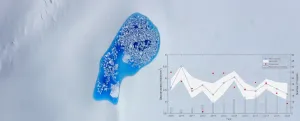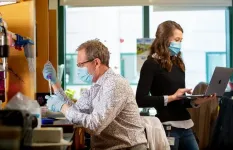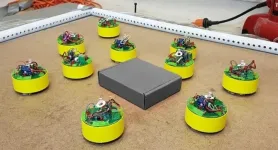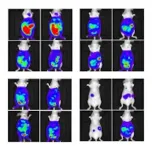A lesson from Arctic sea-ice prediction in 2020: accurate subseasonal-to-seasonal prediction remains a grand challenge
2021-04-24
(Press-News.org) As an indicator and "amplifier" of global climate change, the Arctic's health and stability is the cornerstone of the stability of our climate system. It has far-reaching impacts on ecosystems, coastal resilience, and human settlements in the middle and high latitudes.
The Arctic has experienced amplified warming and extensive sea-ice retreat in recent decades. On 15 September 2020, the Arctic sea-ice extent (SIE) reached its annual minimum, which, based on data from the National Snow and Ice Data Center, was about 3.74 million km2 (1.44 million square miles). This value was about 40% less than the climate average (~6.27 million km2) during 1980-2010. It was second only to the record low (3.34 million km2) set on 16 September 2012, but significantly smaller than the previous second-lowest (4.145 million km2, set on 7 September 2016) and third-lowest (4.147 million km2, set on 14 September 2007) values, making 2020 the second-lowest SIE year of the satellite era (42 years of data).
In 2020, a total of 39 institutions and organizations worldwide submitted their Sea Ice Outlook of the pan-Arctic September SIE. From the June to August SIO, the median of all predictions remained quite stable (4.33 million km2 in June, 4.36 million km2 in July, and 4.3 million km2 in August), which were much higher than the observed value of 3.92 million km2. This indicates that most forecasting systems overestimated the coverage of sea ice in September 2020.
Accurate prediction of Arctic SIE is still a worldwide problem. Recently, a commentary published in Atmospheric and Oceanic Science Letters summarized the predictions from 2009 to 2020, and found that most years' observed values (8 out of 12) fell outside the predicted interquartile range of dynamical models, indicating that it is still a grand challenge to accurately predict the Arctic SIE on subseasonal-to-seasonal (S2S) time scales, especially in extreme years.
"Arctic sea-ice studies require an improved ability to make more accurate predictions and achieve a better understanding of the physics of sea-ice processes", says Prof. Wei, author of this commentary.
In the next step, more efforts should be made to assimilate sea-ice, atmospheric and oceanic observations to generate a skillful initialization. Meanwhile, sea-ice prediction relies on a skillful atmospheric model to produce a high-quality atmospheric forecast. Finally, S2S systems should have the ability to capture changes in sea-ice properties due to global warming, which produces younger and thinner sea ice along with more melt ponds. Thus, improved descriptions of sea-ice processes in sea-ice model components of prediction systems are needed.
Global warming is pushing the Arctic to a dangerous tipping point in which domino-like irreversible processes might be triggered. Therefore, it is essential to develop better Arctic sea-ice prediction systems to serve as the navigation lights to guide us through this uncharted future climate.
INFORMATION:
[Attachments] See images for this press release:

ELSE PRESS RELEASES FROM THIS DATE:
2021-04-23
Anastasia Malashina, a doctoral student at HSE University, has proposed a new method to assess vulnerabilities in encryption systems, which is based on a brute-force search of possible options of symbol deciphering. The algorithm was also implemented in a programme, which can be used to find vulnerabilities in ciphers. The results of the study were published in a paper 'Software development for the study of natural language characteristics'.
Most of online messages are sent in encrypted form since open communication channels are not protected from data interception. Messengers, cloud services, banking systems--all of these ...
2021-04-23
A breakthrough astrophysics code, named Octo-Tiger, simulates the evolution of self-gravitating and rotating systems of arbitrary geometry using adaptive mesh refinement and a new method to parallelize the code to achieve superior speeds.
This new code to model stellar collisions is more expeditious than the established code used for numerical simulations. The research came from a unique collaboration between experimental computer scientists and astrophysicists in the Louisiana State University Department of Physics & Astronomy, the LSU Center for Computation & Technology, Indiana University Kokomo and Macquarie University, Australia, culminating in over of a year of benchmark testing and scientific simulations, supported by multiple NSF grants, ...
2021-04-23
Fentanyl, oxycodone, morphine--these substances are familiar to many as a source of both pain relief and the cause of a painful epidemic of addiction and death.
Scientists have attempted for years to balance the potent pain-relieving properties of opioids with their numerous negative side effects--with mostly mixed results.
Work by John Traynor, Ph.D., and Andrew Alt, Ph.D., and their team at the University of Michigan Edward F. Domino Research Center, funded by the National Institute on Drug Abuse, seeks to side-step these problems by harnessing the body's own ability to block pain.
All opioid drugs--from poppy-derived opium to heroin--work on receptors that are naturally present in the brain and elsewhere in the body. One such receptor, the mu-opioid receptor, ...
2021-04-23
LEBANON, NH - Researchers at Dartmouth's and Dartmouth-Hitchcock's Norris Cotton Cancer Center (NCCC) hope to make estrogen therapy a more accessible treatment option for breast cancer patients who could benefit from it. Anti-estrogen treatments, which block growth signals from estrogen receptors (ER) in tumors, are effective treatments for ER+ breast cancer. But it is common for breast tumors to become resistant to anti-estrogen treatments over time. The research team, led by molecular biologist Todd Miller, PhD, and Nicole Traphagen, a PhD candidate in the Miller Laboratory, found that in mice, cycling between estrogen treatment and anti-estrogen treatment at a specific point in time can dramatically increase ...
2021-04-23
FRANKFURT. Originally, oxygen radicals - reactive oxygen species, or ROS for short - were considered to be exclusively harmful in the body. They are produced, for example, by smoking or UV radiation. Because of their high reactivity, they can damage many important molecules in cells, including the hereditary molecule DNA. As a result, there is a risk of inflammatory reactions and the degeneration of affected cells into cancer cells.
Because of their damaging effect, however, ROS are also deliberately produced by the body, for example by immune or lung epithelial cells, which destroy invading bacteria and viruses with ROS. This requires relatively high ROS concentrations. In low concentrations, on the ...
2021-04-23
Copper remains one of the single most ubiquitous metals in everyday life. As a conductor of heat and electricity, it is utilized in wires, roofing and plumbing, as well as a catalyst for petrochemical plants, solar and electrical conductors and for a wide range of energy related applications. Subsequently, any method to harvest more of the valuable commodity proves a useful endeavor.
Debora Rodrigues, Ezekiel Cullen Professor of Engineering at the University of Houston Cullen College of Engineering, in collaboration with Francisco C. Robles Hernandez, ...
2021-04-23
Anyone with children knows that while controlling one child can be hard, controlling many at once can be nearly impossible. Getting swarms of robots to work collectively can be equally challenging, unless researchers carefully choreograph their interactions -- like planes in formation -- using increasingly sophisticated components and algorithms. But what can be reliably accomplished when the robots on hand are simple, inconsistent, and lack sophisticated programming for coordinated behavior?
A team of researchers led by Dana Randall, ADVANCE Professor of Computing and Daniel Goldman, Dunn Family Professor of Physics, both at Georgia Institute of Technology, sought to show that ...
2021-04-23
Smoking is the leading cause of preventable death in America and causes about 30% of all cancer deaths. That's why researchers with the UC Davis Comprehensive Cancer Center wanted to study the impact of a California law passed in 2016 that raised the tobacco sales age from 18 to 21. Their new study published in Preventive Medicine examines smoking behavior after the state implemented one of the first tobacco 21 (T21) policies.
The study, conducted by UC Davis researchers Melanie Dove, Susan Stewart and Elisa Tong, looked at smoking patterns before and after the law passed and compared California and other states without a T21 policy. The data was from the 2012-2019 Behavioral Risk Factor Surveillance System.
"Most adult tobacco users start smoking ...
2021-04-23
Batteries are a part of everyday modern life, powering everything from laptops, phones and robot vacuums to hearing aids, pacemakers and even electric cars. But these batteries potentially pose safety and environmental risks.
In a study recently published in Cell Reports Physical Science, researchers at Texas A&M University investigated the components of a different kind of battery -- a metal-free, water-based battery -- which would reduce the flammable nature of standard batteries and decrease the number of metal elements used in their production.
Most batteries are ...
2021-04-23
Researchers led by Katsunori Tanaka and Kenward Vong at the RIKEN Cluster for Pioneering Research (CPR) in Japan have demonstrated that tumor growth can be reduced by therapy that tags cancer cells with different therapeutic molecules. In one case, the group was able to prevent tumors from forming in mice by targeting cancer cells with a compound that makes it difficult for the cells to clump together and form tumors. For tumors that already existed, they targeted cancer cells with toxic compounds that destroyed them. This study was published on April 23 in Science Advances.
One of the major problems with current cancer treatments is that their effects are not limited to cancerous cells in ...
LAST 30 PRESS RELEASES:
[Press-News.org] A lesson from Arctic sea-ice prediction in 2020: accurate subseasonal-to-seasonal prediction remains a grand challenge




